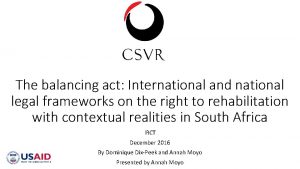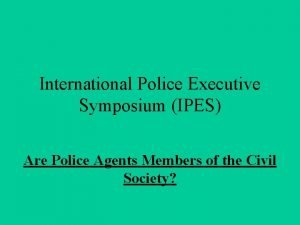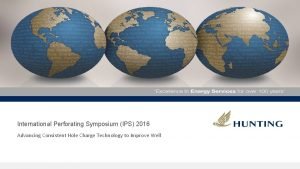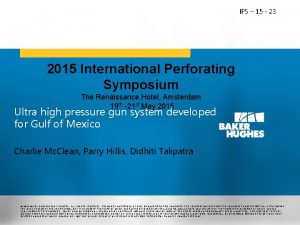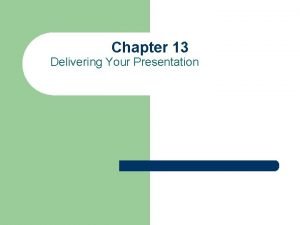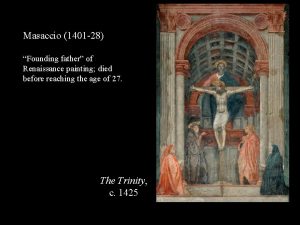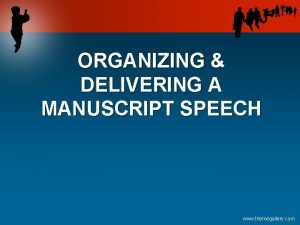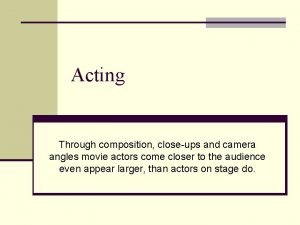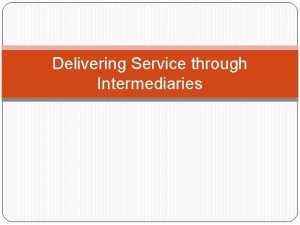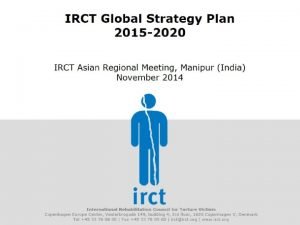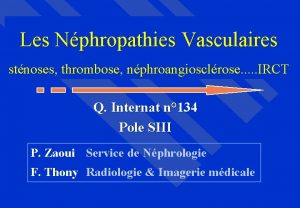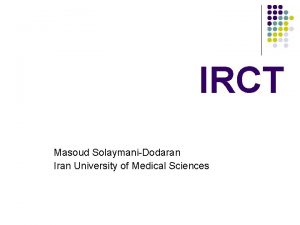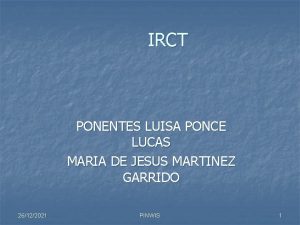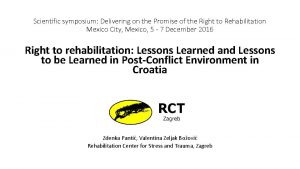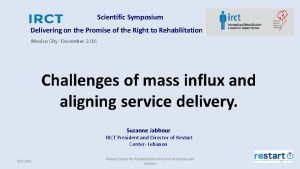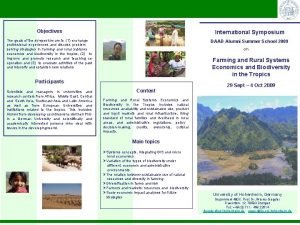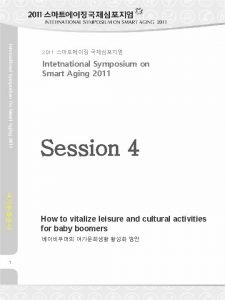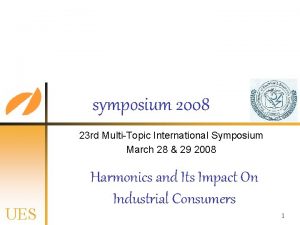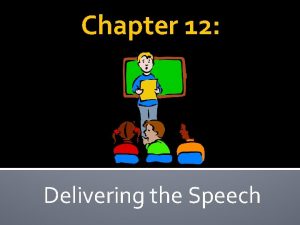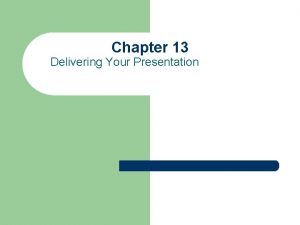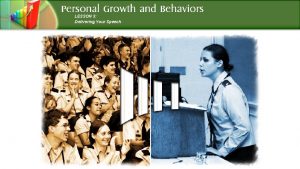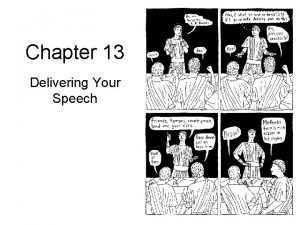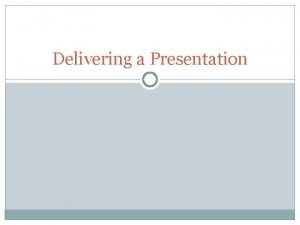IRCT 10 th International Scientific Symposium Delivering on
























- Slides: 24

IRCT 10 th International Scientific Symposium Delivering on the promise of the right to rehabilitation Mexico City, 5 -7 December 2016 Delivering on the Right to Rehabilitation: Successes, Lessons and Challenges A Kenya Civil Society Perspective Peter Kiama Executive Director Independent Medico-Legal Unit (IMLU), Kenya

The Independent Medico-Legal Unit (IMLU) is a governance, health and human rights non-profit making organization, whose vision is A Just World Free from Torture. Our work is underpinned by a holistic approach involving litigation, medical and psychosocial rehabilitation of survivors of torture, monitoring government adherence to its human rights obligations and advocacy for policy, legal and institutional reforms. Over the last two decades we have assisted over 4, 000 victims of torture, cruel, degrading and inhuman treatment through the support of our national networks of professionals: doctors, trauma counselors, lawyers, human rights monitors and journalists. • Independent Medico-Legal Unit, a member of IRCT, has supported rehabilitation and redress for over 4, 000 victims of torture and ill-treatment in Kenya since 1993. • We have applied innovative approaches to enhance access to comprehensive rehabilitation for survivors as per the United Nations Convention against Torture and General Comment No. 3. • This ‘Oral Presentation’ will be based on a paper covering: experiences providing rehabilitation as a global justice, legal and public health issue; state accountability; interface with public and private health systems; use of clinical evidence for advocacy and communications; resourcing rehabilitation; broadening the basis for survivor identification, referrals and rehabilitation

Global Context Globally the normative framework for the prevention and response to torture and ill treatment is ably articulated in the UN Convention against Torture. Numerous other global and regional guidelines and or instruments have been developed among them General Comment N 0. 3 by CAT, the African …… OPCAT, among others However practice has continued to contradict the principles of international norms from Guatanamo and other arenas for countering terrorism, violent extremism and organized crime, to routine law enforcement arena, to measures against pro-democracy movements in many countries including Kenya. `The right to be free from torture and ill-treatment is a rule of customary international law and a peremptory jus cogens norm of international law applying to all States. It is codified in international and regional treaties and national legal systems globally; it constitutes a grave breach of the Geneva Conventions of 1949 and a violation of common article 3 and of customary international humanitarian law; and it can constitute a crime against humanity or an act of genocide under international criminal law. The obligation to prevent torture and ill-treatment applies at all times, including during the investigation of serious crimes and in situations of armed conflict, and is complemented by a range of attendant standards and procedural safeguards. –JUAN MENDEZ, ANNUAL REPORT-2016

Global Context While Torture would have been largely associated with repression and suppression of persons and communities regarded as dissidents or threats to state power, this has mutated to now include some of the most vulnerable persons and communities; poor urban and rural residents, small scale traders and hawkers in cities and municipalities (IMLU Survey 2016; IMLU Research 2014). The persistent use of unlawful and improper interviewing practices is triggered by a range of local factors, including the erroneous assumption that mistreatment and coercion are necessary to obtain confessions or elicit information. The misconception that torture is a “necessary evil” is especially prevalent during interviews relating to organized crime and national security offences. In the anti-terrorism context, Governments resort to “ticking bomb scenarios” in attempts to justify the use of abusive and unlawful interviewing practices, implicitly challenging the absolute and nonderogable nature of the torture prohibition under any circumstances. While some have sought to proffer faulty legal interpretations to support the use of torture, a more common policy option has been to refute that certain practices amount to torture or ill-treatment under international law. In many countries, detainees are mistreated during investigations of common crimes. Pressure from politicians, supervisors, judges and prosecutors to solve high volumes of cases and inadequate measures of police performance, including systems of appraisal focusing only on the number of crimes “solved” or convictions, create perverse incentives for arrests and mistreatment. A lack of forensic methodology, training in modern criminal investigation techniques and equipment often also creates the perception that torture, ill-treatment and coercion are the easiest and swiftest ways to elicit confessions or other information. –JUAN MENDEZ 2016 122 or more countries tortured or otherwise ill-treated people-AI 2015/2016 ANNUAL REPORT

Kenyan Context • Torture and ill-treatment still systemic and widespread in Kenya; • National Torture Prevalence Survey 2011 23% of Kenyans have experienced torture; 0 nly 25% of these, made a formal report; 77% say no action was taken; 59% of the perpetrators are the Regular Police; Poverty is the main driving factor at 48%. • National Torture Prevalence Survey 2016, • 30. 3% of 2400 survey respondents had suffered physical and psychological torture; majority in custody e. g. 39. 4% police cells, 21. 6% on the way to the police station and 19. 6% at the time of arrest; 31. 5% at home, • 60% had suffered psychological effects as a result; 52. 4% had suffered physical injuries as a result. • 27. 9% indicated that they had reported these incidents to an institution or some kind of authority figure; 60. 5% of the respondents indicated that no action was taken after these incidents were reported with just 8. 3% stating that these incidents resulted in perpetrators being arrested, charged in court and convicted.

Kenyan Context • The Truth justice and Reconciliation Report covered the period 12 December 1963 and 28 February 2008; found that: • torture and ill-treatment included the following: detention in water-logged cells; being sprayed with hot and cold water; denial of food, water and medical attention; beatings; humiliation; and the use of insects to terrorize and attack detainees; • Recommended provision of reparation for victims of unlawful detention, torture and illtreatment -REPARATOINS FUND DECLARATION, MARCH 2014; • Implementation of prisons and police reforms • Enactment of legislation prohibiting all forms of torture and other forms of cruel, inhuman or degrading treatment or punishment committed both by state and non-state actors; • President offers a public apology to all victims of torture and unlawful detention and acknowledge the role of the state in the design and use of the Nyayo House torture cells for torture purposes –President issued a public apology-March 2014

Kenyan Context • Kenya has ratified OPCAT and submits reports to CAT- 2008; 2013. Yet to ratify OPCAT; • Domestication • Constitution of Kenya 2010 prohibits torture; • Absence of comprehensive law against torture: however torture is prohibited in sectoral laws e. g. National Police Service Act 2011; National Intelligence Service Act 2011, etc. these do not cover all actors. Does not provide rehabilitation for survivors and families • Prevention of Torture Bill 2011 -2016: now approved by relevant parliamentary committees, but yet to be tabled on the floor for debate; • Practice-prevention and response • Adherence to UNCAT-Domesticatoin, reporting and monitoring

Understanding the Right to Rehabilitation At IMLU we are guided by the convention in our conceptualization and implementation of interventions as below: Article 1: Definition of Torture • For the purposes of this Convention, the term "torture" means any act by which severe pain or suffering, whether physical or mental, is intentionally inflicted on a person for such purposes as obtaining from him or a third person information or a confession, punishing him for an act he or a third person has committed or is suspected of having committed, or intimidating or coercing him or a third person, or for any reason based on discrimination of any kind, when such pain or suffering is inflicted by or at the instigation of or with the consent or acquiescence of a public official or other person acting in an official capacity. It does not include pain or suffering arising only from, inherent in or incidental to lawful sanctions. • Para 3 - General Comment 3 -Victims are persons who individually or collectively suffered harm, including physical or mental injury, emotional suffering, economic loss or substantial impairment of their fundamental rights, through acts or omissions that constitute violations of the Convention. • A person should be considered a victim regardless of whether the perpetrator of the violation is identified, apprehended, prosecuted or convicted, and regardless of any familial or other relationship between the perpetrator and the victim.

Understanding the Right to Rehabilitation • The term “victim‟ also includes affected immediate family or dependants of the victim as well as persons who have suffered harm in intervening to assist victims or to prevent victimization. • The term “survivors” may, in some cases, be preferred by persons who have suffered harm. The Committee uses the legal term “victims” without prejudice to other terms which may be preferable in specific contexts. • Why is rehabilitation important? • Para 4 -The Committee emphasizes the importance of victim participation in the redress process, and that the restoration of the dignity of the victim is the ultimate objective in the provision of redress.

Guidelines to Victim Rehabilitatoin • Article 14: CAT (1. Each State Party shall ensure in its legal system that the victim of an act of torture obtains redress and has an enforceable right to fair and adequate compensation, including the means for as full rehabilitation as possible. • In the event of the death of the victim as a result of an act of torture, his dependants shall be entitled to compensation.

Guidelines to Rehabilitation IRCT UNCAT Holistic; medical; psychological care; legal and social services. Available, Appropriate, Accessible Adopt a long-term and integrated approach and ensure that specialized services for the victim of torture or ill-treatment are available, appropriate and promptly accessible. Provided in a way that guarantees the safety and personal integrity of the victims, their family and their caretakers; Restore victim independence, physical, mental, social and vocational ability; full inclusion; participation in society. Provided at the earliest possible after the torture event, without a requirement for the victim to pursue judicial remedies, on recommendations by qualified health professional; Be embedded in legislation that establishes concrete mechanisms victim rehabilitation High priority on the need to create a context of confidence and trust in assistance provision. Confidential services should be provided as required Accessible to all victims without discrimination Provided in close consultation with the victim and tailored to meet the specific needs of each victim; Adequately funded by national governments. Take into account victims culture, personality, history and background

Briefing on IMLU services • Guiding principles

Interacting with public health systems to secure rehabilitation across Contexts IMLU interacts with public health systems in various ways in the course of rehabilitation as follows: • Survivors who report to IMLU after already receiving initial medical treatment • Cases of death where bodies of victims are in public morgues • Cases of survivors who have been referred to public health facilities by judicial officers for medical reports to ascertain their complaints of torture • Referrals of survivors to IMLU by public health professionals within IMLU network of doctors • Reports from police surgeon who fills in P 3 forms for survivors • Prison health personnel

Interacting with public health systems to secure rehabilitation in Kenya Successes Upon realizing most doctors are within the public health system, we have trained over 150 doctors and clinical officers who form our national network of doctors against torture-they provide critical support to victims at two levels: a) They examine, treat, do medical legal reports, and appear in court as expert witnesses as professionals in their own right; b) Doctors in the public sector examine, treat, write medical legal reports and appear in court as expert witnesses when cases of survivors are referred to them by IMLU- 90% of medical rehab work is provided in this manner; c) P athologists in the public sector examine, treat, write medical legal and forensic medical reports, and appear in court as expert witnesses when cases of death are referred to them by IMLU-strictly using Istanbul Protocol- 90% of medical rehab work is provided in this manner; Senior government doctors and pathologists, including the police surgeon and the Chief Government Pathologist have embraced the Istanbul protocol and using it more often to improve medical legal documentation of injuries from torture and ill-treatment, and forensic medical legal reports in cases of death in custody; Some of the senior doctors and pathologists in the public sector have been at the forefront: a) in the development of a curriculum at masters degree level on Forensic Medicine at the University of Nairobi; b) Development of, and advocacy for the National Coroners Service Bill 2016 which has been approved by Cabinet, and is before relevant parliamentary committee;

Interacting with public health systems to secure rehabilitation in Kenya Challenges • very challenging for most health professionals will want to treat this as normal injuries, write ‘normal’ reports, • difficult to provide treatment summaries/medical reports or write medical legal report; • in most cases victims have to pay to get medical reports from public hospitals, while it is a challenge to get medical report/file from private hospitals, • partnership with private hospitals that are more affordable, are ready to provide compassionate care and give reports, are ready to treat on credit, • establishing a network of doctors and trauma counsellors to provide below market rehab support; conflict related settings: migration contexts etc)

Broadening the basis for survivor identification, referrals and rehabilitation responses through public sector actors such as police, military, judiciary, prosecutors, health care providers and professional bodies • In the last 10 years the Independent Medico-Legal Unit has expanded its work beyond he capital city and major towns to over 42 of the 47 counties through partnership with health care providers and professionals, with the aim of broadening survivor identification, referrals and rehabilitation responses, and to ensure that these services are not only available but appropriate and accessible especially to the most vulnerable and marginalized. • We have trained over a hundred doctors and pathologists on the Istanbul protocol and retained over 50 of these as active pro bono doctors who provide medical examination of victims and recommend and or provide medical rehabilitation to victims in coordination with IMLU. • Pathologists on the network carry out autopsies of bodies of victims and provide relevant medical legal reports for litigation and advocacy purposes. • 90% of these doctors and pathologists work as public health professionals and are therefore the first point of call for victims who present at public health facilities. • They therefore also act as sources of referral, confidentially alerting us of victims who are presenting at these facilities and asking for our intervention. Pathologists in government morgues also act as critical contacts, often times confidentially alerting where they suspect that bodies presented by police at public morgues may have been as a result of torture or other violation by public officials. • Reporting APP-coalition of NGOS and grassroot movements to promote the use of the APP • Research-DIGNITY, EDINBURG

Broadening the basis for survivor identification, referrals and rehabilitation responses through public sector actors such as police, military, judiciary, prosecutors, health care providers and professional bodies • These doctors and pathologists are critical in criminal proceedings or civil cases for compensation of victims, acting as expert witnesses where medical-legal reports are part of the court proceedings. • We have also made attempts to involve other public sector actors such as police, judiciary, prosecutors and prison authorities in broadening the basis for survivor identification, referrals and rehabilitation responses, but with minimal success. This has been through capacity building trainings for police, prosecutors, and judicial staff and prison personnel including health personnel in prisons. • To ensure the delivery of a holistic model of rehabilitation we have also established a 240 strong network of volunteers including 31 journalists; 56 lawyers, 58 doctors and pathologists, 39 counsellors 9 paralegals, 47 human rights monitors who in total cover 42 out of the 47 counties in Kenya. These professionals act as sources of referral or support for survivors to access medical rehabilitation and care, after care follow up to ensure reintegration and safety and security concerns, support in the litigation process.

Broadening the basis for survivor identification, referrals and rehabilitation responses through public sector actors such as police, military, judiciary, prosecutors, health care providers and professional bodies • Every professional is trained on linkages with other professions i. e. • Judicial officers are trained on appreciation of medical and psychological aspects • Doctors are trained on legal and psychological aspects • Lawyers are trained on medical and psychological aspects • Counselors are trained on legal and medical aspects • Journalists are trained on legal and psychological aspects

Broadening the basis for survivor identification, referrals and rehabilitation responses through public sector actors such as police, military, judiciary, prosecutors, health care providers and professional bodies • Within the judiciary we have supported the Court User Committees at several court stations and trained judicial officers on various provisions of international and municipal law relating to torture and ill-treatment. We have also placed paralegals in a number of court stations to help identify and support survivors who appear in those stations. • A few judicial officers have shown interest in ensuring that accused persons who complain of torture in court are accorded a medical examination and, or treatment, while others have called for police to account for injuries to criminal suspects. Other judicial officers been very receptive of the paralegals, enabling them to have access to suspects in court and document their issues for appropriate action. • However the other actors have been largely non-responsive, with the police remaining as the main perpetrators of torture and ill-treatment, and refusing to acknowledge this problem as institutional and therefore being unable to comprehensively address it.

Implementing the right to rehabilitation as a global justice, legal and public health issue Article 14: (1. Each State Party shall ensure in its legal system that the victim of an act of torture obtains redress and has an enforceable right to fair and adequate compensation, including the means for as full rehabilitation as possible. In the event of the death of the victim as a result of an act of torture, his dependants shall be entitled to compensation. The right to rehabilitation is a global justice issue for it addresses the restoration of human dignity often times destroyed through physical and psychological harm, and restitution to address the harm caused to the social, economic and cultural well being of the individual and, or communities. As IRCT has clearly stated: The aim of rehabilitation is to empower the torture victim to resume as full a life as possible. Rebuilding the life of someone whose dignity has been destroyed takes time and as a result long-term material, medical, psychological and social support is needed. The right to rehabilitation is also clearly a global legal issue for it concerns violations of specific international, regional and municipal legal norms, that amount to human rights violations guaranteed through these norms, and therefore seeks to compensation for these violations and punishment for perpetrator. The absolute and non-derogable nature of the torture prohibition in international law reflects the exceptional gravity of the crime, which constitutes an immoral affront to human dignity that can never be justified. It is a public health issue due to the harmful impact on the physical and psychological well being of individuals, families and communities. “Torture dehumanizes and denies the inherent dignity of victims by treating their bodies and minds as means to achieving particular ends. It constitutes one of the most extreme forms of suffering that a person can inflict on another and often results in lifelong consequences for victims”. -JUAN MENDEZ, 2015 ANNUAL REPORT

Successes • In the period 2011 -2016 period we: • Provided Trauma counselling to 1025 primary and secondary survivors. • Provided medical documentation and rehabilitation to 615 survivors of torture and ill treatment; • Reached 1349 persons detained in prisons mainly in pre-trial detention. ………………………………………………………………… • Conducted 122 post mortem reports on persons dead from torture, ill treatment and extra-judicial executions, • Provided legal advice ( including accompaniment to police stations) to 1144 survivors and relatives • 82 Criminal defence and civil litigations; • 9 Public interest cases; • 24 Constitutional petitions; • 52 cash bail for HRDs and survivors; • Minimal protection to 25 witnesses.

Challenges • Dwindling funding for anti-torture work especially rehab; • Victim and witness intimidation and elimination-protection; • Non-domestication of UNCAT-provision on rehab and all sectors • No government rehabilitation program-hence yet to meet the standards of availability accessibility, and appropriate and secure; • Lack specific knowledge about torture and its consequences among most health professionals. Many believe the myths that -that torture is isolated incidents-it is necessary in the interests of protecting national securitysome do not appreciate long lasting physical or psychological damage to victims;

Challenges • May professionals including lawyers and health professionals do not understand their role in investigating and documenting allegations of torture allegations; • Dilemma- Health professionals often face dual obligations and may be torn between their loyalties toward the state versus the patient; especially in Kenya where many of them are in public service; • Lack of awareness of and, or disregard for the Istanbul Protocol; low capacity death investigation system;

THANK YOU
 Irct hotelaria
Irct hotelaria Irct
Irct International symposium on molecular spectroscopy
International symposium on molecular spectroscopy International police executive symposium
International police executive symposium International perforating symposium
International perforating symposium Ips perforating
Ips perforating International perforating symposium
International perforating symposium International perforating symposium
International perforating symposium International perforating symposium
International perforating symposium International perforating symposium
International perforating symposium Scientific inquiry vs scientific method
Scientific inquiry vs scientific method How is a scientific law different from a scientific theory?
How is a scientific law different from a scientific theory? Extemporaneous speech
Extemporaneous speech French and indian war
French and indian war Delivering business value with it at hefty hardware
Delivering business value with it at hefty hardware Father of renaissance art
Father of renaissance art Delivering the nuclear promise
Delivering the nuclear promise Marketing channels delivering customer value
Marketing channels delivering customer value Organizing and delivering a manuscript speech
Organizing and delivering a manuscript speech Delivering lines based loosely on the written
Delivering lines based loosely on the written Delivering the nuclear promise
Delivering the nuclear promise Health and wellbeing 2026
Health and wellbeing 2026 Delivering services through intermediaries
Delivering services through intermediaries Designing and delivering oral and online presentations
Designing and delivering oral and online presentations Delivering the future
Delivering the future

